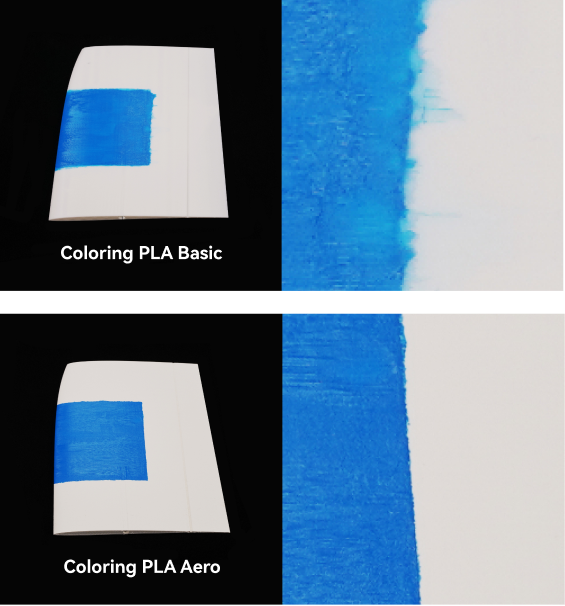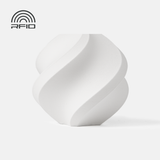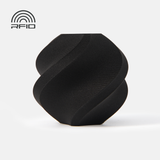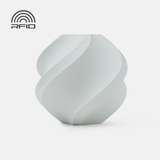Bambu PLA Aero
Bambu PLA Aero achieves low density and light weight by foaming at high temperatures during printing and creating small holes inside the prints. It's the perfect choice for light-weight and energy-saving prints, including unmanned aerial vehicles (UAVs), aerodynamic models, and gliders.
Foaming PLA materials (PLA Aero) have high requirements for material drying and parameter settings. Please carefully read Instructions for printing aircraft model with foaming PLA (PLA Aero) before starting the printing process.


Low Density and Light Weight
Bambu PLA Aero has almost the same filament density as regular PLA, while the prints density is only 50% to 80%.



* When printing models of the same volume, PLA Aero is about half the weight of PLA Basic.


* When printing models of the same volume, PLA Aero is about half the weight of PLA Basic.
Controllable Model Density
Achieve lower density of the prints by increasing printing temperature and lowering flow rate.


* The average density of prints will vary with changes in parameters such as actual printing temperature, flow rate ratio, printing speed, model size, wall thickness and infill density.
| Parameter Setting | Average Density | |
| Printing Temperature | Increases ↗ | Decreases ↘ |
| Printing Speed | Increases ↗ | Stable or Increases ↗ |
| Flow Rate Ratio | Increases ↗ | Increases ↗ |
| Model Size | Increases ↗ | Decreases ↘ |
| Wall Thickness(Wall loops) | Increases ↗ | Increases ↗ |
| Infill Density | Increases ↗ | Increases ↗ |
Tough with Good Impact Resistance
Compared to pre-foaming Wood PLA, Bambu PLA Aero and its prints are tougher and more resistant to impact, collision, and falling.
Matte Finish For Easy Coloring
Bambu PLA Aero provides an easy-to-color matte surface texture with better dyeing results as compared to PLA Basic.


Parameters Comparison
Learn more different filaments comparison on Bambu Filament Guide >>
| PLA Basic | PLA Aero | |
| Printing Temperature | 190 - 230 ℃ | 210 - 260 ℃ |
| Printing Speed | < 300 mm/s | < 250 mm/s |
| Flow Rate Ratio | 0.96 - 1 | 0.5 - 0.8 |
| Filament Density | 1.24 g/cm³ | 1.21 g/cm³ |
| Foaming Rate | / | 0 - 120% |
| Prints Density | 1.21 kg/m³ | 0.55 - 1.05 kg/m³ |
Accessory Compatibility
| Recommended | Not Recommended | |
| Build Plate | Cool Plate, High Temperature Plate or Textured PEI Plate | / |
| Hotend | 0.4 mm Nozzle (All type) | 0.6 mm / 0.8mm Nozzle |
| Glue | Bambu Liquid Glue Glue Stick |
/ |
RFID for Intelligent Printing
All printing parameters are embedded in RFID, which can be read through our AMS (Automatic Material System).
Load and print! No more tedious setting steps.


| Recommended Printing Settings | |
| Drying Settings (Blast Drying Oven) | 55 °C,8 h |
| Printing and Keeping Container's Humidity | < 20% RH (Sealed, with Desiccant) |
| Nozzle Temperature | 210 - 260 °C |
| Bed Temperature (with Glue) | 35 - 45 °C |
| Printing Speed | < 250 mm/s |
| Physical Properties | |
| Density | 1.21 g/cm³ |
| Vicar Softening Temperature | 56 °C |
| Heat Deflection Temperature | 54 °C |
| Melting Temperature | 154 °C |
| Melt Index | 5.0 ± 0.6 g/10 min |
| Mechanical Properties | |
| Tensile Strength | 26 ± 2 MPa |
| Breaking Elongation Rate | 2.2 ± 0.8 % |
| Bending Modulus | 1960 ± 110 MPa |
| Bending Strength | 52 ± 3 MPa |
| Impact Strength | 24.5 ± 1.7 kJ/m² |
Printing Tips
• PLA Aero filament is relatively soft which may result in material loading and unloading failures during AMS printing.
• PLA Aero is prone to stringing and material leakage when it gets wet. Recommended drying condition is 55 ℃ for 8 hours in a blast drying oven, and 75 ℃ for 12 hours on printer's heatbed. Learn more about filament drying. Please refer to Filament drying cover on WIKI.
What's in the Box?


Filament with Spool*1 & Desiccant*1


Filament Label*1


Package*1








